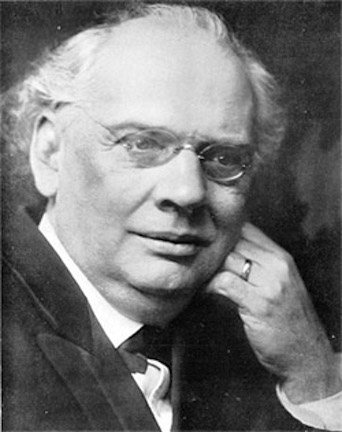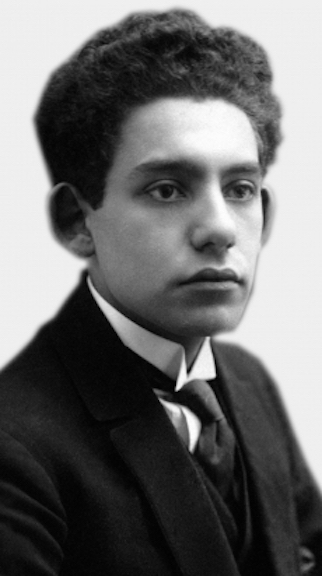The Well-Tempered Ear
Classical music: Oakwood Chamber Players take a “Journey” to explore neglected and oppressed German and Dutch composers this Saturday night and Sunday afternoon | May 16, 2018
By Jacob Stockinger
The accomplished and acclaimed Oakwood Chamber Players (below) continue their exploration of neglected repertoire and end their “Journey” season with two performances of a concert titled Legacy on this Saturday night, May 19, at 7 p.m. and on Sunday afternoon, May 20, at 2 p.m.
The concerts will be held at the Oakwood Center for Arts and Education, 6209 Mineral Point Road, on Madison’s far west side near West Towne Mall.
Tickets can be purchased with cash or personal checks at the door: $25 general admission, $20 seniors and $5 students. Visit www.oakwoodchamberplayers.com for more information.
Trio for flute, clarinet and bassoon by Dutch composer Julius Röntgen (below) was written in 1917 and is neo-Classical in style. Röntgen was a classmate and lifelong friend of Edvard Grieg’s whom he met at the Leipzig Conservatory. He studied with Lachner and Reinecke, and collaborated with Brahms and Casals in concerts. His musical career spanned the roles of composer, teacher, and concert pianist. He was instrumental in the founding of the Amsterdam Conservatory and the world-famous Concertgebouw Orchestra.
A frequent participant in chamber music himself, he was a fine contributor to the genre. Röntgen’s Wind Trio in G Major shows his compositional facility: from a playful Haydn-influenced first movement (which you can hear in the YouTube video at the bottom) to an adagio melody in the second movement that is drawn from Johann Sebastian Bach’s “St. Matthew’s Passion” and to the final movement with a Danish folk melody at its heart that is enhanced by upbeat creative variations.
German composer Heinrich Kaminski (below) wrote his atmospheric String Quartet in F major. Written over the time period leading up to World War I, this four-movement piece encompasses moodiness contrasted with high energy. The scherzo movement has the feel of a driven dance, the adagio movement is emotionally charged, and Kaminski’s final movement recaps themes of the piece’s restless expressivity.
Recognition of his talent in Berlin was cut short when the Nazi Gestapo intercepted correspondence that revealed Jewish heritage. His music was deemed unsuitable for performance in Germany and banned in 1937. He fled to Switzerland yet his life was profoundly impacted by events. He died shortly after the war, having endured the dissolution of his marriage, declining health and loss of children. However interest in Kaminski’s unique composition style has led to resurgence in recent performances of his works.
Dutch composer Leo Smit (below) studied at the Amsterdam Conservatory and then lived in Paris for a decade before returning to Holland. He was greatly influenced by Ravel and Stravinsky’s innovations and exchanged ideas with fellow composers Darius Milhaud, Francis Poulenc and Arthur Honegger. He enjoyed jazz rhythms and they often are found in his works.
His three-movement Sextet for piano and wind quintet is full of variety, warm melodic lines and fascinating harmonies. With the German invasion during World War II Smit’s circumstances as a Jewish musician deteriorated and he was forbidden to continue as a professional musician. Despite the dire circumstances he continued composing, completing a Sonata for flute and piano in 1943 just prior to his transportation to and death in a concentration camp.
The program ends with a cleverly written piece by German composer Bernhard Sekles (below). The final movement from his Capriccio for violin, cello and piano is titled Yankee-Doodle with variations and a delightful way to conclude the concert. Based in Frankfurt, Sekles was an innovative composer and teacher, and in 1928 became the first European teacher of jazz.
Oakwood Chamber Players members are Marilyn Chohaney, flute; Amanda Szczys, bassoon; Anne Aley, horn; Leyla Sanyer, violin; and Maggie Darby Townsend, cello. They will be joined by guests Martha Fischer, piano; Elspeth Stalter-Clouse, violin; Shannon Farley, viola; Aaron Hill, oboe; and Bernard Parish, clarinet.
The Oakwood Chamber Players are a group of Madison-area professional musicians who play in other professional organizations such as the Madison Symphony Orchestra and the Wisconsin Chamber Orchestra, and who have rehearsed and performed at Oakwood Village for over 30 years.
# # #
The Oakwood Chamber Players are a professional music ensemble proudly supported by Oakwood Lutheran Senior Ministries and the Oakwood Foundation.
Tags: #AmsterdamConservatory, #ArthurHonegger, #BannedArt, #BannedMusic, #BerlinGermany, #CarlReinecke, #ConcentrationCamp, #ConcertgebouwOrchestra, #ConcertPianist, #DariusMilhaud, #DutchComposer, #EdvardGrieg, #EuropeanComposer, #EuropeanMusician, #FolkMelody, #FrancisPoulenc, #FranzJosephHaydn, #GermanComposers, #GermanMusic, #HeinrichKaminski, #IgorStravinsky, #JazzMusic, #JewishComposers, #JewishMusic, #JohannesBrahms, #JohannSebastianBach, #JuliusRontgen, #LeipzigConservatory, #LeipzigGermany, #LutheranReligion, #MadisonSymphonyOrchestra, #MauriceRavel, #NaziGermany, #NaziGestapo, #NaziPersecution, #NeglectedComposers, #NeglectedRepertoire, #OakwoodChamberPlayers, #PabloCasals, #ParisFrance, #St.MatthewPassion, #ThemeAndVariations, #WestTowneMall, #WisconsinChamberOrchestra, #WorldWarI, #WorldWarII, #YankeeDoodle, Amsterdam, Arts, Bach, ban, Baroque, Bassoon, Berlin, Carl Reinecke, Cello, Chamber music, children, clarinet, Classical music, composer, Concertgebouw, conservatory, Danish, Denmark, Dutch, energy, Europe, European, flute, genre, Germany, Gestapo, Grieg, Haydn, Health, Holland, influence, Jacob Stockinger, Jazz, Jewish, Johann Sebastian Bach, Julius Rontgen, LeoSmit, loss, Lutheran, Madison, Madison Symphony Orchestra, melody, mood, Music, Nazi, neo-Classical, Netherlands, Oakwood Chamber Players, Oakwood Village, Paris, performance, Piano, repertoire, rhythm, sextet, Sonata, style, Switzerland, Teacher, theme and variations, trio, United States, University of Wisconsin-Madison School of Music, University of Wisconsin–Madison, Viola, Violin, war, winds, Wisconsin, Wisconsin Chamber Orchestra, World War I, World War II, YouTube
4 Comments »
Leave a comment Cancel reply
This site uses Akismet to reduce spam. Learn how your comment data is processed.
- May 2024
- April 2024
- March 2024
- February 2024
- January 2024
- December 2023
- November 2023
- October 2023
- September 2023
- August 2023
- July 2023
- June 2023
- May 2023
- April 2023
- March 2023
- February 2023
- January 2023
- December 2022
- October 2022
- September 2022
- June 2022
- May 2022
- April 2022
- March 2022
- July 2021
- June 2021
- May 2021
- April 2021
- March 2021
- February 2021
- January 2021
- December 2020
- November 2020
- October 2020
- September 2020
- August 2020
- July 2020
- June 2020
- May 2020
- April 2020
- March 2020
- February 2020
- January 2020
- December 2019
- November 2019
- October 2019
- September 2019
- August 2019
- July 2019
- June 2019
- May 2019
- April 2019
- March 2019
- February 2019
- January 2019
- December 2018
- November 2018
- October 2018
- September 2018
- August 2018
- July 2018
- June 2018
- May 2018
- April 2018
- March 2018
- February 2018
- January 2018
- December 2017
- November 2017
- October 2017
- September 2017
- August 2017
- July 2017
- June 2017
- May 2017
- April 2017
- March 2017
- February 2017
- January 2017
- December 2016
- November 2016
- October 2016
- September 2016
- August 2016
- July 2016
- June 2016
- May 2016
- April 2016
- March 2016
- February 2016
- January 2016
- December 2015
- November 2015
- October 2015
- September 2015
- August 2015
- July 2015
- June 2015
- May 2015
- April 2015
- March 2015
- February 2015
- January 2015
- December 2014
- November 2014
- October 2014
- September 2014
- August 2014
- July 2014
- June 2014
- May 2014
- April 2014
- March 2014
- February 2014
- January 2014
- December 2013
- November 2013
- October 2013
- September 2013
- August 2013
- July 2013
- June 2013
- May 2013
- April 2013
- March 2013
- February 2013
- January 2013
- December 2012
- November 2012
- October 2012
- September 2012
- August 2012
- July 2012
- June 2012
- May 2012
- April 2012
- March 2012
- February 2012
- January 2012
- December 2011
- November 2011
- October 2011
- September 2011
- August 2011
- July 2011
- June 2011
- May 2011
- April 2011
- March 2011
- February 2011
- January 2011
- December 2010
- November 2010
- October 2010
- September 2010
- August 2010
- July 2010
- June 2010
- May 2010
- April 2010
- March 2010
- February 2010
- January 2010
- December 2009
- November 2009
- October 2009
- September 2009
- August 2009
Archives
- 2,493,305 hits
Blog Stats
- What classical piano music is played in Season 3 of ‘Bridgerton’? May 22, 2024
- Yunchan Lim’s Chopin etudes are the best ever May 20, 2024
- What do you think of the ‘new’ Wisconsin Public Radio? May 18, 2024
- Here’s music to mark Mother’s Day May 11, 2024
- What made Beethoven sick and deaf? May 9, 2024
Recent Posts
Recent Comments
| welltemperedear on What do you think of the… | |
| Scott on What do you think of the… | |
| welltemperedear on Yunchan Lim’s Chopin etudes ar… | |
| bratschespeilerin on What do you think of the… | |
| MARVIN P WICKENS on Yunchan Lim’s Chopin etudes ar… |
Tags
#BlogPost #BlogPosting #ChamberMusic #FacebookPost #FacebookPosting #MeadWitterSchoolofMusic #TheEar #UniversityofWisconsin-Madison #YouTubevideo Arts audience Bach Baroque Beethoven blog Cello Chamber music choral music Classical music Compact Disc composer Concert concerto conductor Early music Facebook forward Franz Schubert George Frideric Handel Jacob Stockinger Johannes Brahms Johann Sebastian Bach John DeMain like link Ludwig van Beethoven Madison Madison Opera Madison Symphony Orchestra Mead Witter School of Music Mozart Music New Music New York City NPR opera Orchestra Overture Center performer Pianist Piano post posting program share singer Sonata song soprano String quartet Student symphony tag The Ear United States University of Wisconsin-Madison School of Music University of Wisconsin–Madison Viola Violin vocal music Wisconsin Wisconsin Chamber Orchestra wisconsin public radio Wolfgang Amadeus Mozart YouTube




Many composers, especially those who were Jewish, gay, or Romanish, were persecuted by the Nazis in the 1930’s.
Leo Smit, for example, was killed at Sobibor extermination camp in 1943 at the age of 43.
The Leo Smit Foundation continues to spread the word about his work and that of other similarly persecuted composers. See
http://www.leosmit.org/leosmitfoundation.php#.WvwIgKSFPIV
and the website Forbidden Music Regained:
http://www.forbiddenmusicregained.org/?DOC_INST=1
You can find scores, historical materials including biographies and pictures and more at both web sites.
Again, interesting programming in Madison.
LikeLike
Comment by fflambeau — May 16, 2018 @ 5:32 am
It’s a delightful idea to spotlight neglected composers.
By continuing to focus on “war horses” and overplayed and recorded composers, gatekeepers of classical music do a great injustice to many, many talented individuals.
I noted that one of the first recordings that the new conductor of the New York Philharmonic made with that group was a recording of…Beethoven’s 5th symphony. Did he add to our understanding of that work (especially since so many outstanding conductors have recorded it)?
So hats off to this group.
LikeLike
Comment by fflambeau — May 16, 2018 @ 12:07 am
Thanks so much for your comments, fflambeau! We work really hard on our programming, finding much current relevance and joy in playing works that might go unsung otherwise. This results in many Wisconsin premieres, not to mention that we also program a lot of new contemporary works. This is our special niche, and we love it! Our audiences love the music, too!
LikeLike
Comment by Marilyn Chohaney — May 16, 2018 @ 11:02 am
I’m glad to hear, Dr. Chohaney, that your audiences love this kind of music and that you enjoy performing it.
Maybe your innovative programming should serve as a wake-up call to those who think that classical music consists only of Bach, Beethoven, Mozart, Haydn, and Brahms.
LikeLike
Comment by fflambeau — May 16, 2018 @ 10:18 pm